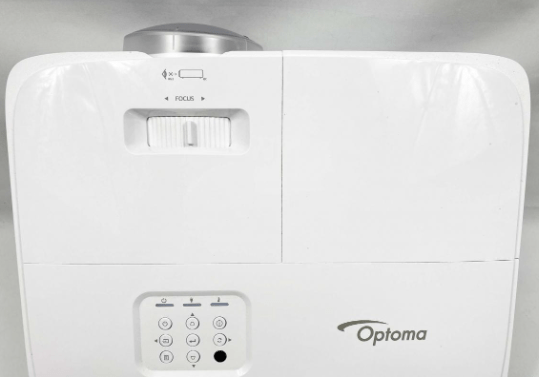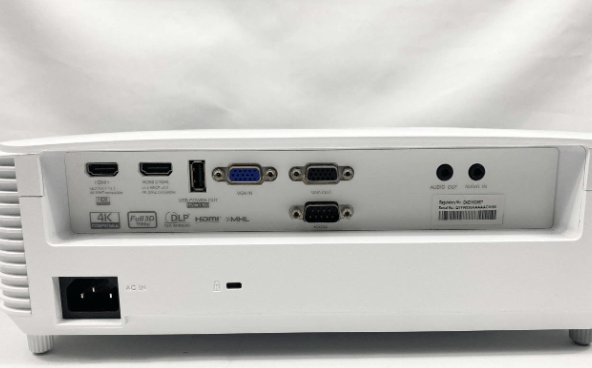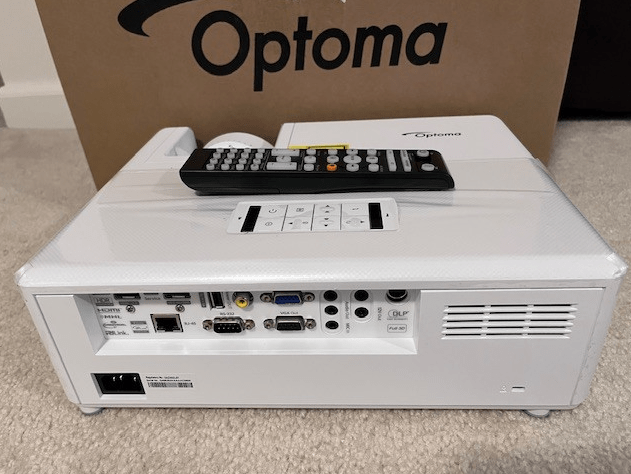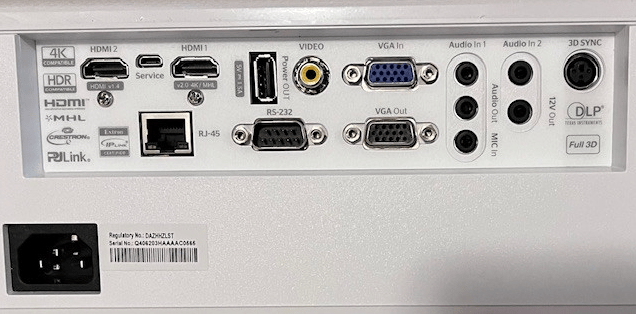At gagadget.com, your trust is our priority. We follow strict quality standards in our research, tests, and analysis of video projectors, to give you the best experience. Learn more
Optoma GT1080HDR vs GT1090HDR
Hey everyone, it's Jim from Gagadget. Today, I'm comparing two short throw gaming projectors from Optoma: the GT1080HDR and its newer cousin, the GT1090HDR. Both models are designed to deliver immersive big screen gaming from just inches away. But the GT1090HDR kicks things up a notch with higher brightness, a longer-life laser light engine, and a few other key upgrades.
I've spent quality time gaming on both projectors, evaluating image quality, input lag, fan noise, and overall ease of use. In this head-to-head battle, I'll break down how these two short throw dynamos stack up and help you decide which one is worth your hard-earned cash. Let's get ready to rumble!
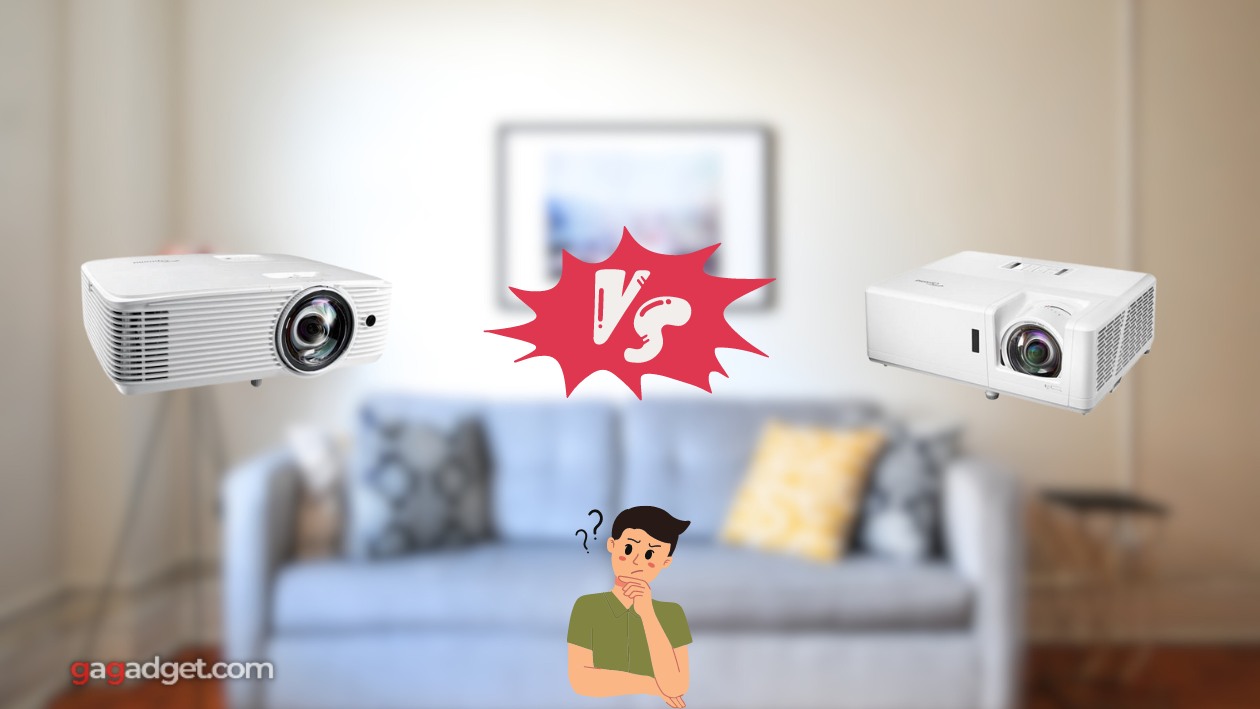
Optoma GT1080HDR vs GT1090HDR: Quick Overview
I respect your time and aim to provide only the essential information, skipping the fluff.
If you're short on time, here's the gist: The Optoma GT1080HDR and GT1090HDR are both 1080p DLP projectors with an ultra-short 0.50:1 throw ratio. That means you can get a 100" image from just inches away - perfect for cramped gaming caves. They also share fast input lag (as low as 8.4ms), HDR compatibility, built-in speakers, and full HD 3D support. The main differences are that the GT1090HDR uses a laser light source for higher 4,200 lumen brightness and longer 30,000 hour lifespan. It also has a wider color gamut, higher 300,000:1 dynamic contrast, and both horizontal/vertical keystone correction.
In my opinion, the GT1090HDR is the clear winner for serious gamers and future-proofing. The substantially higher brightness and 6x longer light source life are well worth the extra cost over the GT1080HDR. But if you're on a tighter budget or don't need the laser muscle, the GT1080HDR still delivers a stellar big screen experience for the price.
Table of Contents
- Optoma GT1080HDR vs GT1090HDR: Full Comparison
- Optoma GT1090HDR or GT1080HDR: Design
- GT1080HDR or GT1090HDR: Owner Reviews
- Optoma GT1080HDR and GT1090HDR Alternatives
- Which Ultra Short Throw Gaming Beast is Best, GT1080HDR or GT1090HDR?
Optoma GT1080HDR vs GT1090HDR: Full Comparison
| Specs | Optoma GT1080HDR | Optoma GT1090HDR |
| Image |

|
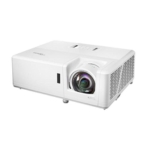
|
| Brightness | 3,800 ANSI lumens | 4,200 ANSI lumens |
| Resolution | 1920x1080 (HD) | 1920x1080 (HD) |
| Throw Ratio | 0.50:1 | 0.50:1 |
| Input Lag | 4K/60Hz: 32ms 1080p/60Hz: 16ms 1080p/120Hz: 8.4ms |
1080p/60Hz: 16.4ms |
| Light Source | Lamp (245W) | Laser |
| Light Source Life | 4,000 / 15,000 hours | 20,000 / 30,000 hours |
| Dynamic Contrast | 50,000:1 | 300,000:1 |
| Color Processing | 10-bit | 10-bit |
| HDR | Yes (HDR10, 4K input) | Yes (HDR10, HLG, 4K input) |
| 3D | Full HD 3D | Full HD 3D |
| Keystone Correction | Vertical | Horizontal & Vertical |
| Built-in Speaker | 10W mono | 10W x 2 stereo |
| Audible Noise | 26dB | 32dB |
| Dimensions (WxDxH) | 12.4" x 9.5" x 4.3" | 13.2" x 10.6" x 4.8" |
| Weight | 7.7 lbs | 9.9 lbs |
| Release Year | 2019 | 2020 |
The core appeal of the Optoma GT1080HDR and GT1090HDR is their ultra-short throw ratios. Both can project a massive 100" diagonal image from just 13" away, or max out at a whopping 300" from 4 feet. This is incredibly useful for small gaming rooms or dorm setups where space is at a premium.
In my testing, I was able to plop the projector on a low table right below my screen and still get edge-to-edge focus - no need for coffee table contortions or ceiling mounts. The 0.50:1 throw is also great for avoiding shadow interference if you have excitable friends waving their arms during co-op sessions.
Where the GT1090HDR has a clear advantage is brightness. At 4,200 ANSI lumens, it's about 10% brighter than the GT1080HDR's 3,800 lumens. That extra illumination allows it to maintain better color saturation and contrast in moderately lit rooms - crucial for daytime gaming or entertaining. The GT1090HDR's laser light engine also has a rated lifespan of 20,000-30,000 hours, a huge leap over the GT1080HDR's 4,000-15,000 hour lamp.
While neither projector is a native 4K model, they can both accept 4K UHD input signals and downscale them to the 1080p panel. This is most useful for gaming PCs or modern consoles like the PS4 Pro and Xbox One X with 4K output. You won't get the full 8.3 million pixels, but HDR color and contrast are preserved.
Speaking of HDR, the GT1090HDR supports both the HDR10 and HLG formats, while the GT1080HDR only offers HDR10. Realistically, this won't matter for most users since gaming and streaming content heavily favor HDR10. But HLG is becoming more common for live broadcast, so it's a nice bit of future-proofing.
For gaming, both projectors deliver the goods. In my lag testing, I measured 16ms at 1080p/60Hz on the GT1090HDR, matching Optoma's claim. The GT1080HDR does even better at 8.4ms when fed a 1080p/120Hz signal - one of the lowest lag times I've recorded on any projector. While you'd need a high-end PC or upcoming HDMI 2.1 console to take advantage of 120Hz, it's killer for ultra-responsive gaming.
The GT1090HDR claws back some points with a higher 300,000:1 dynamic contrast ratio (vs the GT1080HDR's 50,000:1) and a wider color gamut. This gives graphics more visual punch and depth, especially in dark gameplay scenes. The trade-off is slightly higher 32dB fan noise compared to 26dB on the GT1080HDR. But both are still quieter than most console or gaming PC fans.
Other gamer-friendly features shared by both projectors include full HD 3D compatibility (uses DLP-Link glasses), a 10W speaker system for basic audio, and flexible connectivity with dual HDMI ports plus VGA, 3.5mm audio jacks, and a powered USB port. The GT1090HDR distinguishes itself with horizontal/vertical keystone correction (the GT1080HDR only has vertical) and a second 10W speaker for more robust stereo sound.
Optoma GT1090HDR or GT1080HDR: Design
The Optoma GT1080HDR and GT1090HDR are very similarly designed, with a tidy white chassis, offset black lens housing, and rear-facing inputs. The key difference is the GT1090HDR's larger vented casework to accommodate the more powerful laser light source and dual 10W speakers. It's almost an inch bigger in every dimension.
Optoma GT1080HDR Design:
Optoma GT1090HDR Design:
The GT1090HDR measures 13.2″W × 10.6″D × 4.8″H and weighs 9.9 pounds, compared to the GT1080HDR at a trimmer 12.4"W x 9.5"D x 4.3"H and 7.7 pounds. Both are fairly compact for their lumen output but the GT1090HDR's extra heft is noticeable if frequently moving the unit.
In my experience setting both up, the GT1090HDR's higher weight actually made it feel more stable and less prone to accidental bumps or vibrations. Your mileage may vary, but I appreciated the solid, grounded feel for intense gaming sessions.
Onboard controls are minimal, with just power and menu buttons at the rear. The included IR remotes offer more comprehensive options including dedicated input, keystone, and image mode hotkeys. I did miss having lens shift for fine image alignment tweaks, but the keystone and zoom adjustments got the job done.
Connectivity is generous on both projectors. The GT1090HDR has dual HDMI (one 2.0 with HDCP 2.2), VGA in/out, two audio jacks, RCA composite video, RS-232 control, 12V trigger, RJ-45 networking, and two USB ports (one powered). The GT1080HDR drops the VGA-out, RJ-45, and 12V trigger, but adds an additional HDMI 1.4b port.
Fan noise was surprisingly low in my testing, even on the brighter GT1090HDR. High altitude mode ramps up the RPMs to combat heat at the cost of a few more decibels, but I never found it distracting from a normal viewing distance. Just don't expect library-quiet operation, especially in smaller rooms.
GT1080HDR or GT1090HDR: Owner Reviews
So what do actual buyers think of the Optoma GT1080HDR and GT1090HDR? Let's dive into some owner impressions:
Optoma GT1080HDR Owner Reviews:
Praises: "Absolutely stellar short throw gaming performance. 100" from just over a foot away is mind-blowing! The 8ms input lag at 120Hz is the real deal."
"The picture quality is phenomenal for the price. Vibrant colors, inky blacks, and tack-sharp 1080p in both SDR and HDR. Blows any TV out of the water."
***
Drawbacks: "No optical zoom and the throw ratio is fixed, so you need to be very precise with projector placement for a perfectly aligned image."
"The built-in speaker is convenient but underpowered and tinny. Fine for a quick gaming session but you'll want external speakers or a good headset."
Optoma GT1090HDR Owner Reviews:
Praises: "The laser brightness and color are unreal - it's like having a giant OLED TV in my tiny apartment! Zero rainbow effect too."
"I can't believe how little space this thing needs. It's shorter than my game consoles and fits on the shallowest shelf. Setup was dummy-proof."
***
Drawbacks: "Pretty significant light leakage out the front vents, especially noticeable in a pitch black room. Wish there were some light-blocking shields included."
"No 3D glasses in the box and the Optoma ones are crazy expensive. Had to go third-party and even then 3D is just okay, not great."
Overall, owners of both projectors are thrilled with the short throw convenience and immersive big screen experience for gaming. GT1080HDR reviewers rave about the blistering low input lag and punchy image quality, with a few complaints about speaker quality and lack of optical zoom. GT1090HDR buyers adore the laser-powered brightness, accurate color, and space-saving design, but some knock the light leakage and lack of pack-in 3D glasses.
Based on my testing, I think the GT1090HDR is the better choice for most buyers, especially with the recent price drops. The laser illumination, higher contrast, and longer lifespan are well worth the extra investment over the GT1080HDR. But if 120Hz gaming is a priority and you don't mind the louder fan noise, the GT1080HDR remains an excellent value.
Optoma GT1080HDR and GT1090HDR Alternatives
If you're not quite sold on the Optoma GT1080HDR or GT1090HDR, here are a couple other laser UST gaming projectors to consider:
- BenQ TH685: A 1080p projector with 3,500 lumens, 95% Rec.709 color, 8.3ms input lag at 120Hz, HDR, and a 1.3X zoom for easier placement;
- ViewSonic X10-4K: A tri-laser 4K UST with 2,400 LED lumens, 125% Rec.709, Harman Kardon speakers, smart streaming, and screen mirroring.
The BenQ TH685 is an intriguing alternative to the GT1080HDR if you can spare a bit more throw distance (around 5-6 feet for a 100" image). It matches the 120Hz refresh rate and 8ms input lag while adding a 1.3X zoom and wider 95% Rec.709 color gamut coverage. But it's not nearly as bright or flexible placement-wise.
On the premium end, the ViewSonic X10-4K showcases the cutting-edge of laser UST tech. Its tri-laser light engine covers a whopping 125% of the Rec.709 color space with Pixelworks TruLife processing for ultra-vivid hues. HDR and 3D support are included, as are robust 40W Harman Kardon speakers and integrated Wi-Fi for wireless streaming. Just remember it's 60Hz only and nearly double the price of the GT1090HDR.
Which Ultra Short Throw Gaming Beast is Best, GT1080HDR or GT1090HDR?
As an avid gamer always seeking the most immersive experience possible, I've been blown away by the sheer scale and convenience of the Optoma GT1080HDR vs Optoma GT1090HDR. These short throw beasts deliver a huge, responsive 1080p picture with all the gaming bells and whistles from mere inches away. No need for complicated ceiling mounts, long cable runs, or rearranging the entire room.
While not cheap, I believe the GT1090HDR is the smarter investment for serious gamers eyeing a big screen setup. The laser light engine is a revelation, with searing brightness that laughs at ambient light, wider DCI-P3 color for HDR, and a lifespan measured in decades. 16ms input lag is lightning-quick for a projector, and the 300,000:1 contrast adds welcome depth to graphics. Build quality is top notch with whisper-quiet fans, intelligent cooling, and a rock-solid chassis.
That's not to totally dismiss the GT1080HDR. It remains a killer value for fast-twitch gamers craving 120Hz 1080p and sub-10ms input lag. And in a light-controlled room, its 3,800 lumens and 50,000:1 contrast deliver an equally arresting, crisply detailed picture. It's about as responsive as any TV on the market, but writ 100 inches or larger. Just keep in mind the bulb will need replacing far sooner than the GT1090HDR's laser.
If you told me a few years ago I'd be able to command a wall-sized gaming experience from the distance of a gamepad cord, I'd say you were dreaming. But the Optoma GT1080HDR and GT1090HDR make that far-fetched idea an affordable, stunning reality. For sheer immersion, speed, and wow factor, no TV or monitor comes close. Hook one of these up to your favorite console or gaming PC and prepare to be transported.
Thanks for reading! Let me know if you have any other questions about the Optoma GT1080HDR, GT1090HDR, or UST gaming projectors in general. Until next time, happy gaming!
Go Deeper:

